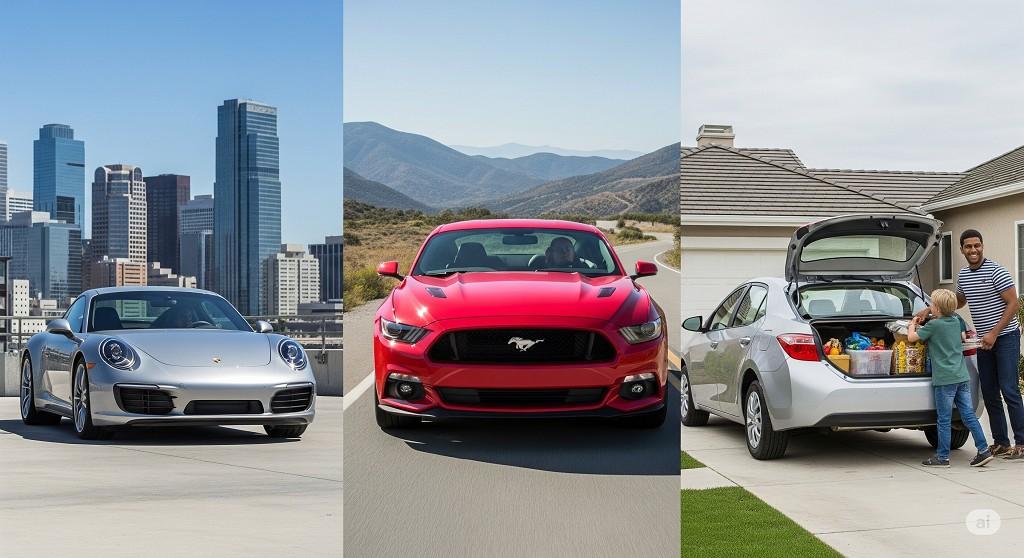
Deciding to choose and buy a car is a significant life event, and it can be a thrilling but also daunting process. But The Car Care Nut – a popular YouTuber known for offering down-to-earth car advice – breaks it down with one clear rule: you can only have two out of three—performance, reliability, and price. This golden triangle is the foundation of any smart car purchase.
The Car Care Nut notes that:
“There are three things that you can only have two of at the same time: good performance, good reliability, or a good price. Very few cars do all three well.”
This means:
- Performance + Reliability = Expensive (e.g., luxury sports cars)
- Performance + Price = Less Reliable (e.g., budget sports cars)
- Reliability + Price = Less Performance (e.g., economy cars like the Toyota Corolla)
Understanding this trade-off is crucial when you choose and buy a car.
Whether you’re eyeing a sporty sedan, a rugged SUV, or a dependable commuter, your priorities determine the best path forward. In this blog, we’ll explore how to navigate these trade-offs and help you confidently choose and buy a car that fits your lifestyle and budget.
Tips to Choose and Buy a Car
- Good Performance + Good Price = Less Reliability
- Good Reliability + Good Price = Less Excitement
- Good Performance + Good Reliability = Higher Price
- Decide your top two priorities before shopping
- Used cars may offer better deals, but come with trade-offs
The Three Pillars of Your Car Buying Decision
Let’s break down this powerful theory to help you set your priorities. A car will typically excel in two of these categories, and understanding which two are most important to you will dictate your entire approach.
- Performance: This is the joy of driving. It’s the car that’s fun, fast, and exciting to be in. It might have a powerful engine, sporty handling, and a captivating design.
- Reliability: This is peace of mind. It’s the car that starts every time, needs minimal repairs beyond routine maintenance, and will be a dependable companion for years.
- Price: This is the bottom line. It’s the car that fits comfortably within your budget, both for the initial purchase and long-term ownership.
So, where do your priorities lie?
- Performance + Price: If you prioritize a fun-to-drive car that doesn’t break the bank, you’re likely looking at a vehicle that sacrifices long-term reliability. Think of high-performance used cars with potentially high maintenance costs.
- Reliability + Price: This is the most common choice for many buyers. It’s a car that is dependable and affordable. However, you’ll probably have to compromise on performance. These are the workhorses of the automotive world—they get the job done without a fuss, but they might not be the most exciting to drive.
- Performance + Reliability: This is the dream combination, and it’s also the most expensive. You get a car that is both thrilling to drive and incredibly durable. But, as The Car Care Nut notes, these cars are rare, and they come at a premium price.
Once you have identified your two most important pillars, you can begin to narrow down your options and decide whether a new or used vehicle is the right path to choose and buy a car.
How to Choose and Buy a New Car
For many, a new car represents a fresh start. It’s the thrill of a brand-new vehicle with that distinctive “new car smell.” Buying new is a fantastic option if you prioritize peace of mind and the latest features.
The Pros of Buying New:
- Warranty: The biggest advantage of a new car is the factory warranty. This covers most parts and labor for several years, giving you significant peace of mind against unexpected repair costs.
- Latest Technology: New cars come equipped with the most up-to-date safety features, infotainment systems, and fuel-efficient powertrains.
- No History: You are the first owner, meaning you have a clean slate. You don’t have to worry about a previous owner’s driving habits or hidden maintenance issues.
- Customization: You can order a new car exactly to your specifications, from the color and trim to specific packages and options.
The Cons of Buying New:
- Depreciation: New cars experience the steepest depreciation. The moment you drive off the lot, your vehicle loses a significant percentage of its value.
- Higher Cost: The initial purchase price is substantially higher than a comparable used model.
- Insurance Costs: Your insurance premiums will likely be higher to cover the full replacement cost of a new vehicle.
How to Choose and Buy a Used Car
Buying a used car is a smart financial decision that has become more appealing than ever. With modern vehicles lasting longer, a used car can offer many years of reliable service at a fraction of the cost of a new one. This is a great choice if your priority is price and reliability, and you’re willing to put in a little extra homework.
The Pros of Buying Used:
- Lower Price: The most obvious benefit is the lower cost. You can get more car for your money, often affording a higher trim level or a luxury model that would be out of reach if purchased new.
- Less Depreciation: Used cars have already absorbed the initial, steep depreciation hit. This means your car will hold its value much better over time.
- More Choices: The used car market is vast and diverse, offering a wider range of makes, models, and years to choose from.
The Cons of Buying Used:
- Lack of Warranty: Most used cars are sold “as is,” and any remaining warranty coverage may be limited. This means you are on the hook for any repairs, such as dashboard replacement.
- Potential for Problems: You are buying a car with a history, and there is a risk of hidden mechanical issues or a lack of proper maintenance from a previous owner.
- Outdated Technology: The safety and entertainment features might be a few years behind the latest models.
How to Choose a Family Car: Practicality is Your Priority
When you choose and buy a car for your family, your priorities shift dramatically. The “performance” pillar often takes a backseat to space, safety, and reliability. Here’s how to apply the principles to find a vehicle that works for everyone.
- Safety Above All: This is your non-negotiable. Look for cars with top-tier safety ratings from organizations like the IIHS or NHTSA. Features like ISOFIX connectors for child seats, multiple airbags, and advanced driver-assistance systems (ADAS) such as automatic emergency braking are essential.
- Think About Space: Will you need to fit three car seats across the back? Do you have enough cargo space for groceries, strollers, and sports gear? Be realistic about your needs. Minivans, three-row SUVs, and large crossovers are popular family choices for a reason—they offer unmatched versatility.
- Consider Maintenance and Longevity: A family car needs to be reliable. Unexpected breakdowns are more than an inconvenience; they can disrupt busy schedules and put your family in a difficult spot. Focusing on brands known for durability and a good price for parts and service (e.g., Toyota, Honda) will pay dividends down the road.
How to Choose a Luxury Car: The True Cost of Ownership
The appeal of a luxury car is its combination of performance and comfort, making it a dream for many. However, the Car Care Nut often warns about the financial realities that come with this dream, especially when buying used. For luxury vehicles, the “price” pillar becomes a much broader calculation.
- Performance and Comfort Come at a Price: A luxury car is a masterclass in the “Performance + Reliability” or “Performance + Price” trade-off. European luxury cars, for example, often offer incredible performance and innovative technology, but their sophisticated engineering can lead to very high repair costs once the warranty expires.
- Maintenance Is Not Optional: Don’t let the initial purchase price of a used luxury car fool you. As The Car Care Nut frequently advises, a luxury car requires luxury-level maintenance. Parts are more expensive, and specialized technicians are often required. A “cheap” used luxury car can quickly become a financial nightmare if you’re not prepared for these expenses.
- Resale Value Varies Wildly: Some luxury brands and models hold their value better than others. For example, brands like Lexus, specializing in what The Car Care Nut calls “boring reliability,” tend to have better long-term value than some of their European counterparts. Researching a specific model’s depreciation rate is vital for making a smart investment.
Making the Right Choice
Regardless of whether you decide to choose and buy a car that is new or used car, here are some final steps to ensure you make the best decision.
- Set a Realistic Budget: Look beyond the sticker price. Factor in insurance, registration fees, sales tax, and an emergency fund for potential repairs.
- For Used Cars: Get a Pre-Purchase Inspection (PPI): This is the most crucial step for buying a used car. Take the vehicle to a trusted independent mechanic for a thorough inspection. They can identify potential issues that you or the seller might miss.
- For Used Cars: Review the Vehicle History Report: Services like Carfax or AutoCheck can provide a detailed report on a car’s past, including accident history, title status, and service records. This is your best defense against buying a lemon.
- Test Drive, Test Drive, Test Drive: Never buy a car without a long test drive. Pay attention to how it handles, listen for strange noises, and ensure you are comfortable in the driver’s seat.
In the end, the right car is a personal choice based on your priorities and budget. By applying the expert advice from The Car Care Nut and following these practical steps, you can confidently choose and buy a car that will serve you well for years to come.
